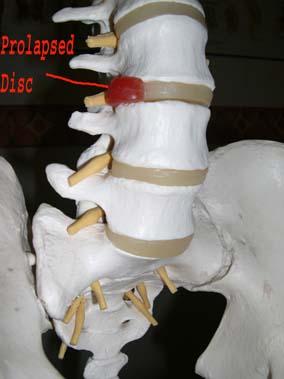Spondylolisthesis
Spondylolisthesis occurs when one vertebra slips forward in relation to the lower vertebra, usually in the lumbar spine or low back.
Spondylolisthesis can be congenital (present from birth), develop during childhood or happen later in life. The condition results from the physical stresses to the spine from lifting, sports such as football or gymnastics, accidents or general wear and tear.
Another type of spondylolisthesis is degenerative spondylolisthesis, occurring usually after age 50. This may create a narrowing of the spinal canal (spinal stenosis).

In younger people (under 18 years old), spondylolisthesis usually involves slippage of the lowest fifth lumbar vertebra over the top of the sacrum. This is because the angle of the spine at this level is usually greatest leading to gravity trying to shear the top vertebrae forwards on the lower one.
Facet joints, the small joints that hold the back of the spine together become damaged at their junction to the vertebral column resulting in the L5 vertebra slipping forward over the top of the sacrum.
Spondylolysis
A condition called spondylolysis can also cause slippage that happens with a spondylolisthesis.
Spondylolysis is a defect in the bony ring comprising the spinal column. It affects the pars interarticularis, the junction between the facet joints and the vertebral body. This defect is due to a stress fracture or breakage that happens from repeated strains on the bones. Participants in certain sports like gymnastics, high board diving, body building and football commonly suffer this damage. Spondylolysis can lead to spondylolisthesis when a damage occurs on both sides of the bony ring. The back section of the facet joints separates from the main vertebral body allowing the vertebra on top to slip forward over the one below.
As mentioned, in younger people (under 18 years old), spondylolisthesis usually involves slippage of the lowest fifth lumbar vertebra over the top of the sacrum. This is because the angle of the spine at this level is usually greatest leading to gravity trying to shear the top vertebrae forwards on the lower one.
Facet joints are small joints that connect the back of the spine together. Normally, the facet joints connecting L5 to the sacrum create a junction to prevent L5 from slipping forwards on the sacrum. However, when problems exist in the disc, facet joints, or bony ring , the junction becomes weakened, resulting in the L5 vertebra slipping forwards over the top of the sacrum.
Degenerative Spondylolisthesis usually affects people over 50 years old. It mainly involves slippage of L4 over L5 although can affect other levels of the spine.
Degenerative changes or wear and tear of the spine can also lead to a spondylolisthesis. Degeneration of the disc between the vertebrae and facet joints of the spine causes the vertebrae to move more than they should, until they becomes loose. The disc degenerates and narrows pressing the facet joints together. Eventually, the support from the facet joints becomes poor and the top vertebra slides gradually forwards. This condition also reduces space in the spinal canal where the vertebra has slipped
Symptoms
An ache in the low back and buttock areas is the most common pain in people with spondylolisthesis. Pain is usually aggrevated when bending backward and may be eased by bending the spine forward. Occasional muscle spasm is also common in the low back and buttock muscles.
When the vertebra slips forward, it puts a painful strain on the disc, facet joints and muscles of the back.
Trapped Nerves
If the slippage gets worse it can also cause nerve trapping. Nerve trapping is a result of pressure on the nerves where they exit the spine. Nerve trapping causes numbness, tingling, pins and needles and muscle weakness in the legs.
Very occasionally the nerves that go to the bladder and rectum can become trapped.
Diagnosis
Your Osteopath will take a careful case history and then examine you in great detail, noting your ranges and quality of movement. He will do minor tests for trapped nerves and in rare cases may request an X ray or MRI scan. He will ask questions about your symptoms and how your problem is affecting you.
When a diagnosis has been reached , your Osteopath will discuss the treatment options with you.
Although a spondylolisthesis can be serious, the vast majority of injuries are not and can easily be helped by your Osteopath. He should normally be able to reduce your symptoms to a pain-free level and give you advice and exercise to help prevent future problems. This condition will most likely need periodic careful maintainance treatment to help prevent serious deterioration.
It is essential that you seek advice quickly because apart from getting an accurate diagnosis, evidence shows that the sooner you consult your osteopath, the quicker you will be better!
